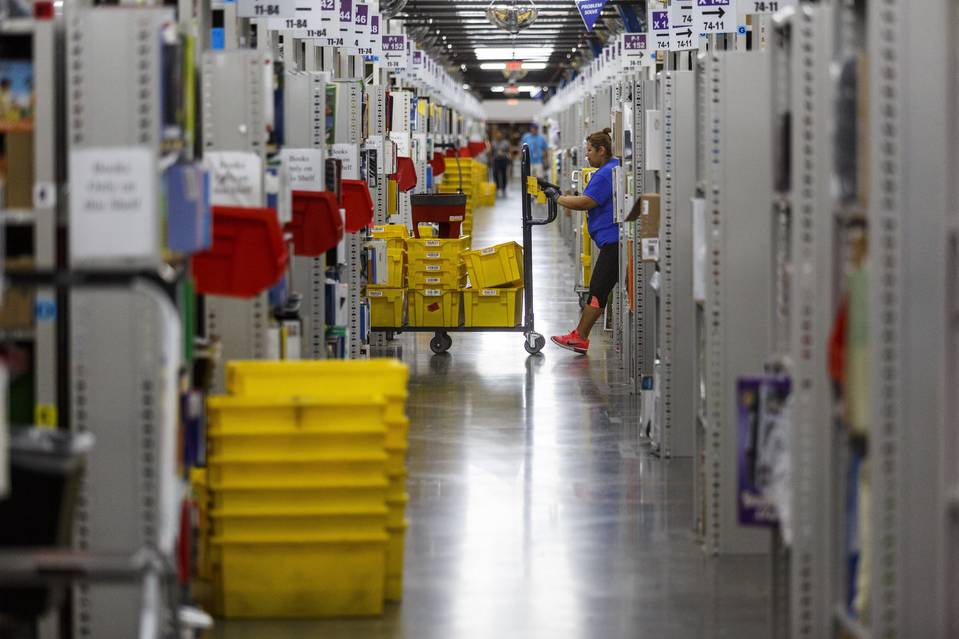An Amazon worker at Chattanooga, Tenn., fulfillment center in August. Photo Credit: Doug Strickland/Associated Press
A fascinating article by Laura Stevens on WSJ (Subscription required) talks about how Amazon sets its third-party “deal of the day”. The first compelling fact that stood out from the article was the scale of revenues generated by third-party sellers on Amazon.
A graph of the total gross merchandise volume (GMV) sold by Amazon, shows that in the recent years, the third-party share of Amazon revenues have increased from 50% to about 70% (even as Amazon’s revenues have exploded).
How are these deals evaluated and picked by Amazon?
Amazon’s deal of the day selections hinge on two important factors—whether it thinks an item will be a hot seller and whether the discount is deep enough. Amazon also takes into account the number of units the seller is willing to offer and customer reviews, among other factors.
It is clear that to qualify small business retailers must offer huge volumes at deep discounts. While the article mentions that Amazon requires a 15% discount for qualifying, most retailers offer a much deeper discount in order to be picked for the deal day. On E-Commerce, Amazon (like Walmart in retail) operates more like a monopsony than a monopoly. Clearly, these deals are very good for Amazon. How about the consumers and the 3rd party vendors?
Consumers
Almost all comments on WSJ discuss how these deals are great for e-commerce consumers. As I argued based on data in the previous post, there has perhaps never been a better time to be a consumer buying in e-commerce channels.
3rd Party Sellers
One of the focal sellers in the article is Tea Forté whose product jumped from rank No. 588 to No. 4 (within Grocery Category)
“For us, the deal of the day is a game changer,” said Jurgen Nebelung, vice president of e-commerce and digital for Concord, Mass.-based Tea Forté. By sacrificing 35% of revenue per unit for the Cyber Monday discount on Amazon, Tea Forté did 6.5 times its normal sales volume on the site.
It is altogether another motive for (Amazon and) Macy’s and Target to offer “doorbuster” deals — A fraction of consumers who come to brick and mortar or the website may buy other products and lift sales for the retailer.
Not so much for the third-party sellers. Consumers buying products on a deal are often not buying other things the third party vendors sell. I am not sure how much the vendor gain. One goal for vendors such as Tea Forté is that consumers become aware of the Tea Forté brand and become its loyal customers. I argue that most consumers on Cyber Monday are just looking for deals.
I did a quick back-of-the-envelope calculation for the above quote from Tea Forté.
Let ![]() be the revenue per unit for the product,
be the revenue per unit for the product, ![]() cost per unit of the product, and
cost per unit of the product, and ![]() be the normal sales volume on the site.
be the normal sales volume on the site.
For the cyber deal revenues (at 65% revenue per unit) to be better than regular revenues, we need
Sales on discounted deal day > regular sales
![]() ,
,
which gives ![]() , which implies cost must be less than
, which implies cost must be less than ![]() of the revenues.
of the revenues.
This implies that the margin >38.5%, (i.e., ![]() ).
).
It is not clear to me that the net margin on the Sampler teas were 38.5% or higher. In any case, as a vendor, unless your firm is making significantly more than 40% profit margin on an item, these deals are barely profitable, and may even churn a loss.
I also did my calculations based on “pure lift” in demand on that day, assuming demand on normal days continues to be the same.
Clearly, this assumption is generous and is typically not true: I think that many consumers would have “bought forward” on the deal day. In other words, those consumers would have bought tea anyway at a later date, instead, they bought the tea they liked ahead of time because of the super-attractive deal. Essentially this deep-discount pushes future sales into the current day. At the time of writing this post, the sales rank had dropped to 69 and 1000+ for their top two products. So, it is quite possible that instead of getting consumers at a 10% discount in March, June and so on, Tea Forte had many consumers buying on deal-day (at 35% discount) paying much less than the usual price.
For sure, some other customers might have gotten the sampler tea from another company and instead became familiar with Tea Forte, which is great for the company. But, are those customers coming back to Tea Forte when the price is at a 10% discount?
This simple analysis shows the pernicious nature of single day “flash sales” for retail businesses.
It is what I call death by a single cut.

